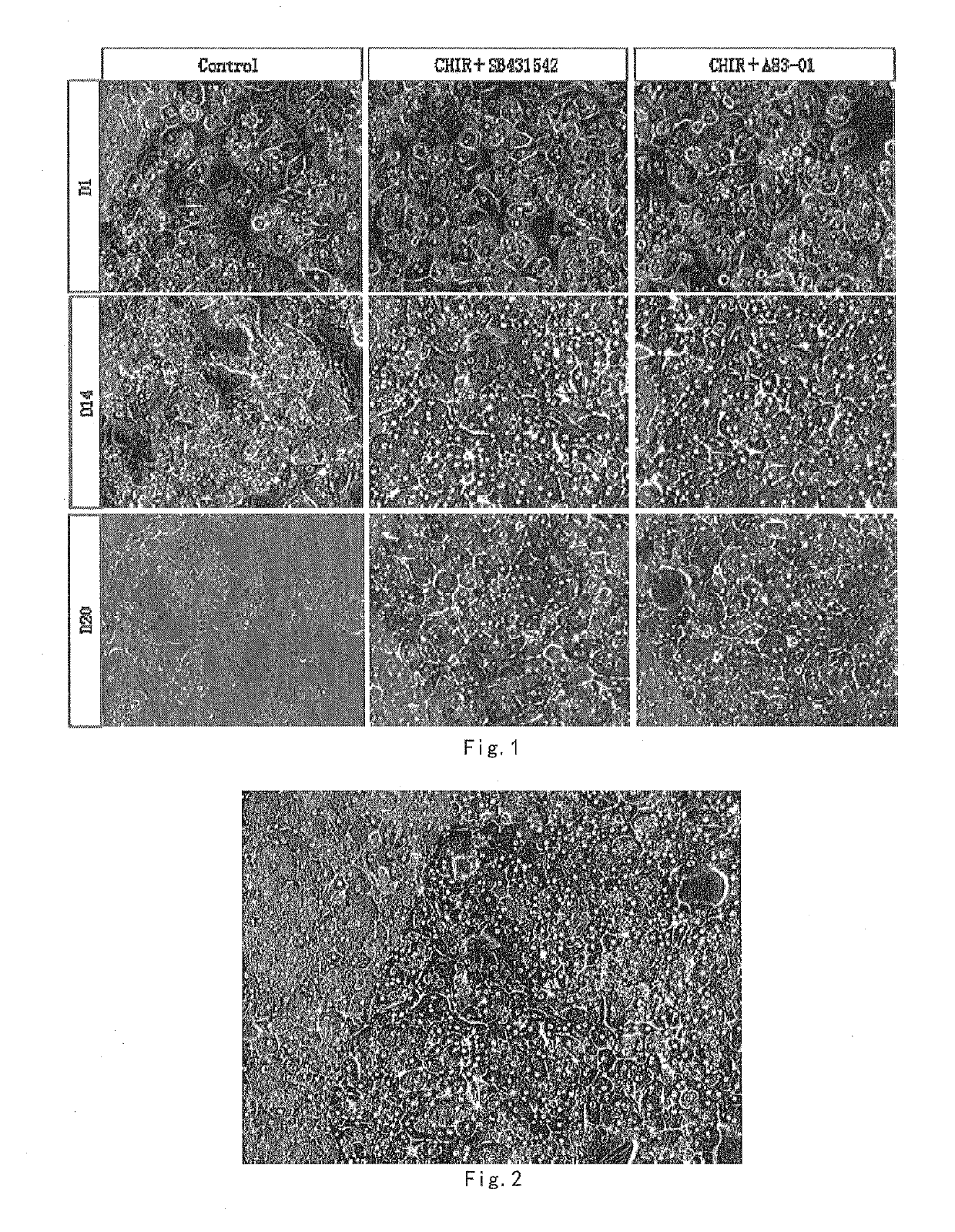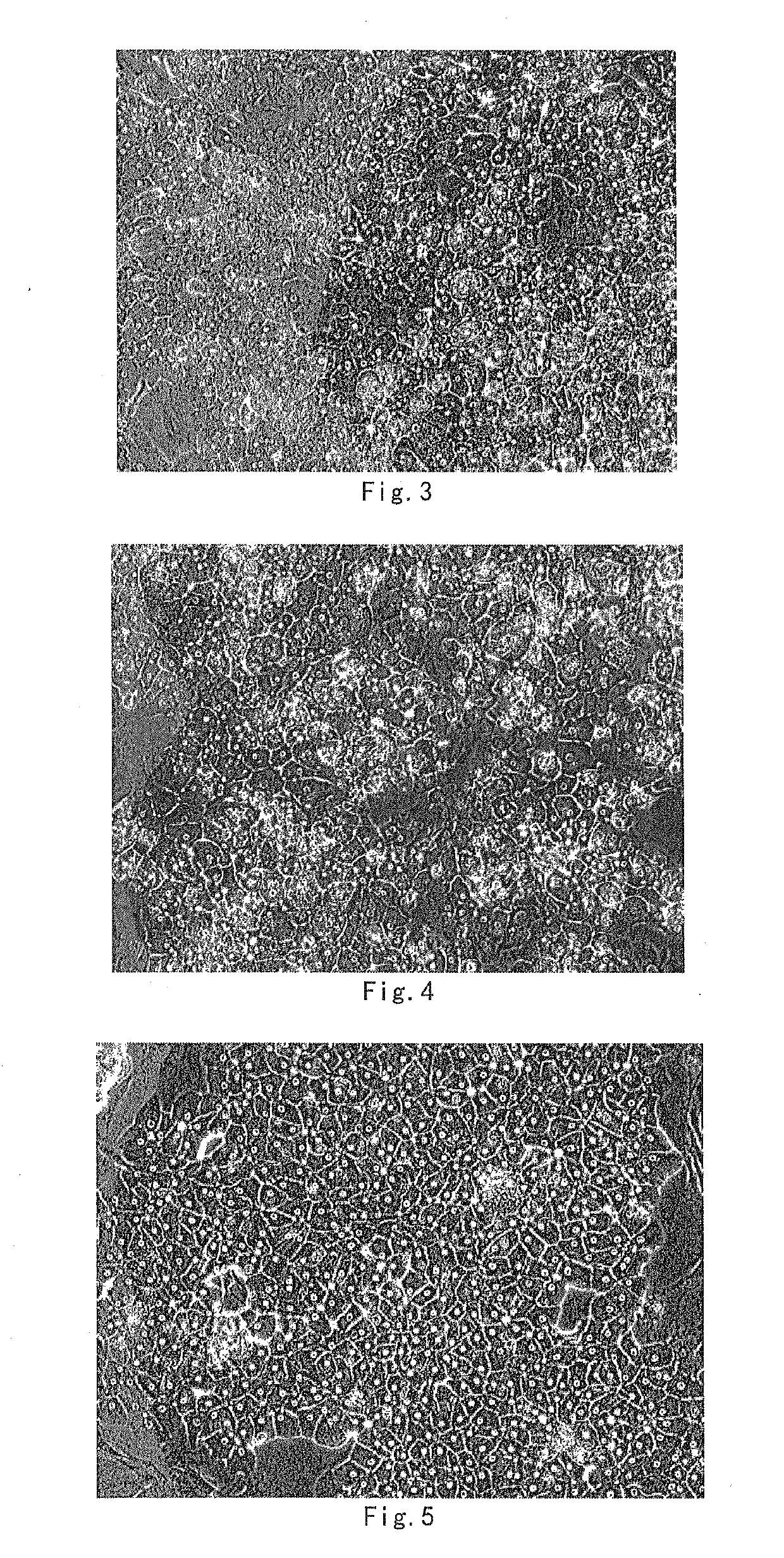Culture method for long-term maintenance and proliferation subculture of human hepatocytes
a technology of human hepatocytes and culture methods, applied in the field of biological and medical science, can solve the problems of short culture time, complicated unconventional culture operations, and lack of liver supply
- Summary
- Abstract
- Description
- Claims
- Application Information
AI Technical Summary
Benefits of technology
Problems solved by technology
Method used
Image
Examples
example 1
, Preparation of Human Hepatocyte Culture Medium
[0082]1{grave over ( )} A hepatocyte basal medium was prepared according to conventional method, i.e., the components of table 4 were added into DMEM / F12 (basal cell culture medium) (in v / v %):
TABLE 4N22.5% B275%non-essential amino acids (Non-AA)1%sodium pyruvate (Sodium pyruvate)1%streptomycin mixed solution (100x)1%
[0083]2{grave over ( )} In the above-described hepatocyte basic culture medium, respectively, components were added with final concentrations as shown in table 5, thereby obtaining hepatocyte culture medium I-1.1 / 2, I-2.1 / 2 and hepatocyte culture medium I-3.1 / 2 / 3 / 4.
TABLE 5mediummediummediummediummediummediummediummediumI -1.1I -1.2I -2.1I -2.2I -3.1I -3.2I -3.3I -3.4GSK3βinhibitor2 μM2 μM1.5μM1.5μM3μM3μM3μM3μMCHIR99021TGFβinhibitor2 μM002μM5μM4μM0μM0μMSB431542TGFβinhibitor A83-0101 μM1.5μM0002.0μM1.5μMN-acetyl-cysteine(NAC)001mM1.25mM3mM6mM1.25mM2.5mMOncostatin M(OSM)005ng / ml10ng / ml020ng / ml40ng / ml0leukemia inhibitory000015...
example 2
, Long-Term Proliferation, Passage and Maintenance of Human Hepatocyte Culture
[0084]1{grave over ( )} Culturing human primary hepatocytes with Hepatocyte culture medium I-1.1, hepatocyte culture medium I-1.2
[0085](1) Primary hepatocytes (isolated product from ablated human liver tissue) were purchased from Life Technology, Inc.
[0086](2) The culture plate was backed with matrigel (1:30) for 1 hour, then the primary hepatocytes were mixed and suspended in adherent culture medium (hepatocyte basal medium supplemented with 10% serum), prior to being plated and incubated at 37° C. for 1 hour;
[0087](3) The culture medium of (2) was discarded, and the hepatocytes are swapped into hepatocyte culture medium I-1.1 and, I-1.2 for culture.
[0088]Cell morphology images were taken at 1, 14, 20 days of culture with hepatocyte culture mediums I-1.1 and I-1.2 (cell cultured without GSK3 beta inhibitor and TGF beta inhibitor was used as a control). The morphological image is as shown in FIG. 1.
[0089]A...
example 3
Characterization of Hepatocyte
[0109](1) Immuno-Staining
[0110]Immuno-staining method is as follows:
[0111]1. Discarding the cell culture solution, rinsing with PBS for one time,
[0112]2. Fixing with 4% Paraformaldehyde for 10 minutes, rinsing in PBS for 5 minutes×3 times,
[0113]3. Blocking with 10% goat serum for 60 min at room temperature;
[0114]4. 0.2% Triton: 25-30 min,
[0115]5. Incubating with the primary antibody (rabbit anti-ALB antibody, mouse anti-CYP3A antibody or a rabbit anti-ASGPR antibodies) for 1 hour at room temperature, or 4° C. overnight,
[0116]6. Rinsing in PBS for 5 minutes×3 times,
[0117]7. Incubating with the secondary antibody (Cy3-labeled goat anti-rabbit antibody, a FITC-labeled goat anti-mouse or goat anti-rabbit antibody) at room temperature for 45 to 60 minutes,
[0118]8. Washing with PBS for 5 min×3 times,
[0119]9. Sealing the slice, and photos were taken under fluorescence microscope.
[0120]The hepatocytes were cultured in vitro in hepatocyte culture medium I-2.2 fo...
PUM
 Login to View More
Login to View More Abstract
Description
Claims
Application Information
 Login to View More
Login to View More - R&D
- Intellectual Property
- Life Sciences
- Materials
- Tech Scout
- Unparalleled Data Quality
- Higher Quality Content
- 60% Fewer Hallucinations
Browse by: Latest US Patents, China's latest patents, Technical Efficacy Thesaurus, Application Domain, Technology Topic, Popular Technical Reports.
© 2025 PatSnap. All rights reserved.Legal|Privacy policy|Modern Slavery Act Transparency Statement|Sitemap|About US| Contact US: help@patsnap.com



